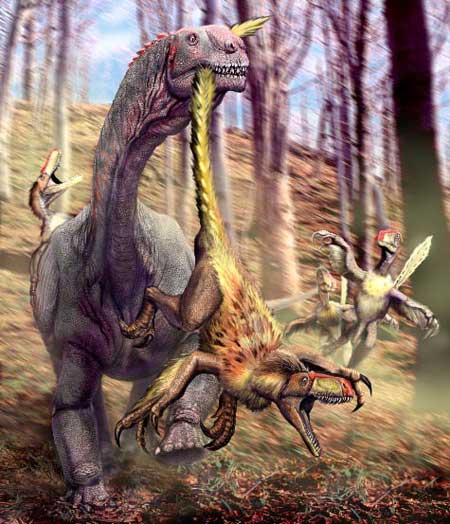New Encyclopedia Digs into Dinosaurs

A new dinosaur encyclopedia explains what these engaging extinct reptiles can teach us about evolution and the effects of climate change, while inspiring fans to move beyond memorizing tongue-twisting species names.
"Dinosaurs, The Most Complete, Up-to-Date Encyclopedia for Dinosaur Lover of All Ages" (Random House Books for Young Readers, 2007), by Thomas R. Holtz, University of Maryland paleontologist, is designed for kids and adults who want to sink their teeth into paleontology, dinosaur family trees, fossilization and the accuracy of dinosaur art. The book is illustrated by well-known dinosaur artist Luis V. Rey.
But for classic dino trivia, an appendix features basic information on about 800 genera of dinosaurs. In this Q&A below, Holtz talks about how dinosaurs compare to mammals, the future of dinosaur paleontology and his favorite dinosaur.
Q: Why are kids so attracted to dinosaurs, compared to other groups of animals?
HOLTZ: It could be because dinosaurs are big and scary like dragons, but they were real creatures, not made up. And yet they can’t get up and come after us, like animals that exist today. Dinosaurs seem to be something that kids can master pretty well and pretty early, and for some reason, they can wrap their minds around the long dinosaur names and the details. I have been a dino geek for as long as I can remember. My parents told me I wanted to BE a dinosaur, a Tyrannosaurus rex, to be precise.
Q: Why do we need to know about these long extinct creatures?
HOLTZ: From a scientific perspective, dinosaurs are cool. They were a very successful group of creatures. They show us the evolution of different groups in the species, with complex behaviors. They encompassed the largest range of size and body plans in terrestrial animals, ranging from the hummingbird to the Argentinosaurus, that only placental mammals have surpassed. And the largest of those, the blue whale, is a sea creature. From an educator’s view, they’re a good hook, they help us understand the evolution of the Earth and the effects of climate change. Their extinction shows us that a bolt from the blue, in Earth time, can change things overnight.
Sign up for the Live Science daily newsletter now
Get the world’s most fascinating discoveries delivered straight to your inbox.
Q: How did dinosaurs compare to mammals?
HOLTZ: Dinosaurs were the top dog, and they were dominant for 135 million years, longer than the mammals have been. Mammals appear at the same time as the dinosaurs, but they were in the dinosaurs’ shadow, because they couldn’t be top predators. It was only with the disappearance of the dinosaurs that mammals could flourish.
Q: Your new book has so many detailed illustrations of different dinosaurs by Luis V. Rey. How do you know what they looked like?
HOLTZ: Any picture of a dinosaur is a based on some knowledge and some speculation. We know, for example, from fossils, that some had feathers, but we don’t know the pattern or color. So Luis’s imagination can go wild with colors.
Q: How is your new book different from other dinosaur books?
HOLTZ: It’s not an A-Z list, because an alphabet listing has no bearing on the history of life. The dinosaurs are a group of animals with a history. Our book is organized by family tree, with major groups and what made them distinctive. We also have contribution from 33 other dinosaur experts.
Q: Do you think we’ll continue to find out more about dinosaurs? HOLTZ: Oh my yes!! New dinosaur species are being named at a rate of about one every two weeks. In the last few months we've seen the announcement of the largest of the bird-like beaked oviraptorosaurs (Gigantoraptor), the likely direct ancestor of Triceratops (Eotriceratops), and one of the largest dinosaurs ever discovered (Futalognkosaurus). Additionally, all sorts of new lines of evidence—especially from CT scans, preserved biomolecules and microscopic histological sections of dinosaur bones—are revealing the inner details of their lives and growth. There are still plenty of new discoveries to be made.
Q: What is your favorite dinosaur today? HOLTZ: It has been, and always shall be, Tyrannosaurus rex. Because it's the coolest! I could add that, intellectually, studying T. rex helps us understand the upper limits of being a terrestrial carnivore and a biped, shows the culmination of a series of adaptations over the course of millions of years, and demonstrates specializations of the skull and limbs that make it an intriguing study in functional morphology. But really, it's my favorite because of its inherent coolness.
- A Brief History of Dinosaurs
- Gallery: Dinosaur Fossils
- Gallery: Drawing Dinosaurs











